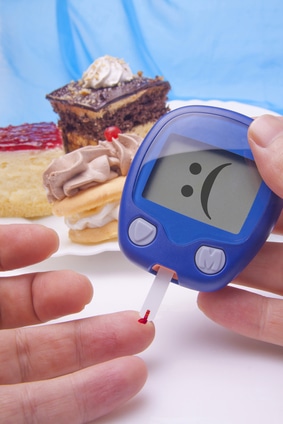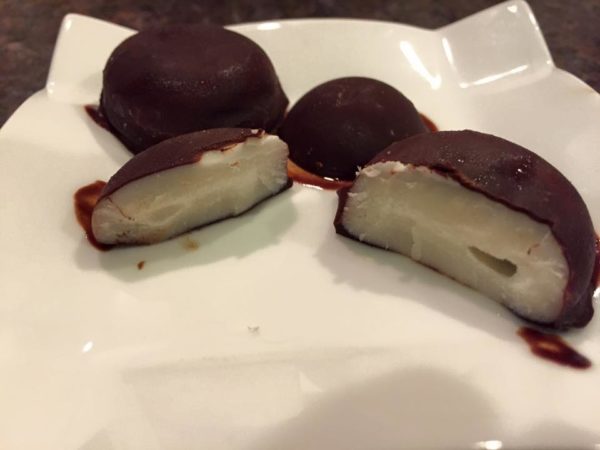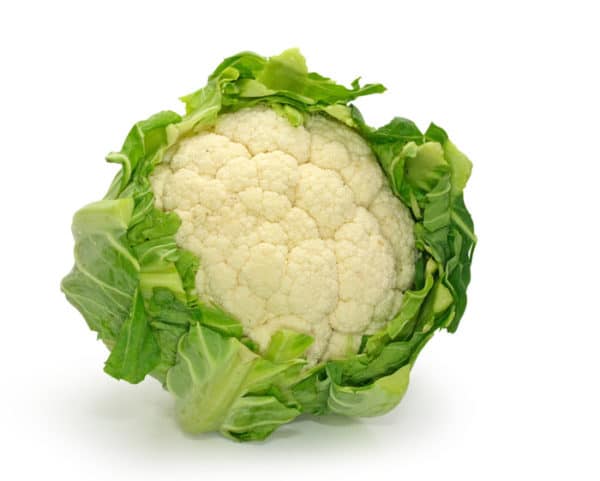

Yes – 50%! It is the root cause of many health symptoms and diseases.
Yet many people don’t know they are walking around with elevated blood sugar. Years ago even I didn’t realize that I had this problem. After all, I ate healthy, exercised, and certainly didn’t eat any packaged foods or sugar.
But guess what…I did a simple finger prick test one day and found out I had a blood sugar problem and was insulin resistant! I couldn’t believe it, but it was true.
What is happening in your body with blood sugar and insulin?
Insulin is produced by the body to get the glucose (sugar) you eat out of your body and into cells where it can be converted to energy. Without insulin, the blood sugar level in your body skyrockets and you become a diabetic. You want the right balance of insulin and blood sugar so that your body gets the nutrients and energy it needs from sugar without any ill effects.
Insulin is produced every time you eat, and it is particularly elevated when you eat foods high in carbohydrates (because that means more glucose). It is also elevated when you are stressed and during other instances (I’ll talk about those below). When insulin production is high, you are in a constant state of inhibited fat burning, low growth hormone, and lowered metabolism. Your body burns the excess glucose for fuel (rather than burning fat!). The end result is you can’t lose the dreaded belly fat.
After a while, the insulin receptors on your cells get tired of the constant insulin stimulation and you 
There is also science that shows there is a connection between blood sugar and your risk for dementia, cancer, and other serious health issues.
What can YOU do about potential blood sugar issues?
You need to be your own health detective to look at what might be happening in your particular body (looking at your diet, stress management, exercise routine, sleep, and more!), and you need to feel empowered to take a simple test.
I’ll talk more about testing in my next blog, but for now, know that there is a simple device you can purchase called a glucose meter. You can get this device at most pharmacies and drug stores for under $15. Find one that has inexpensive replacement test strips.
I usually have my clients take the test multiple times and chart their findings so that they get the best sense of what their baseline is. I recommend taking the test first thing in the morning when you initially get up. Your ideal range should be 75-85 mg/dL (higher is not good). Then I suggest one additional test before eating. And then again after you eat breakfast. Your ideal result should be 110 mg/dL or less (and know that if it is greater than 120 mg/dL you are causing damage to your body!). It is good to take the test (after eating) about ½ hour to an hour after you eat, as that is when your blood sugar should be peaking. You should then be back to your baseline about 2 hours after eating.
Once you have a baseline and are routinely charting your results, you can start to see what impacts your blood sugar! That is where being a good detective comes in. Was it the bad night’s sleep that caused today’s spike? The stressful argument you had with the boss? Soon you will learn something that many people don’t understand:
Elevated blood sugar is NOT just about what you eat.
That’s what happened to me, by the way…it was a lack of sleep that set off my blood sugar spiking! And also a particular food!
Exercise can also cause problems, either with too little exercise or overdoing your workout! I’ve talked about this before, but this is why burst training is healthier than longer durations of aerobic workouts. So, yes, exercise benefits are “dose” dependent! Burst training (short intervals of high intensity followed by rest) elevate your growth hormone (the opposite of elevating blood sugar). The best burst training, by the way, is doing it throughout the day…if you sit at a desk, it is especially important to do a quick burst every once in a while to keep your blood sugar in balance.
Stress can also impact your blood sugar. Read this previous blog about how to reduce your stress!
And yes, you do need to get off of ALL sugar and processed foods! That means no bread, even gluten free, no cookies, crackers (except raw dehydrated ones, made from vegetables, nuts, and seeds), no cakes, pastries, candies, and fruit juice. These foods trigger blood sugar spikes which trigger excess insulin release.
And don’t listen to people who tell you to eat little meals throughout the day (to control blood sugar). NO! That just elevates your insulin all day. That is not what you want to do!
I recommend that my clients also use their glucose meter to test specific fruits to determine which ones they need to eliminate. (I had issues with pineapples!) I also recommend that whenever fruit is consumed it’s taken with green leafy vegetables like lettuce, spinach, and sprouts. In my opinion, smoothies (with lots of greens!) are the best way to eat fruit, as long as the percentage of fruit is low and greens are high.
There are key nutrients that you may want to take as well in order to restore your body’s cell receptivity to insulin. In general, these may be chromium, magnesium, glutamine, zinc, and the B vitamins. DHA is also good; it is an omega 3 fat that’s important for insulin sensitivity. You can work with a practitioner to get tested to determine the best nutrients for you as it can vary from person to person.
As an initial step, go out and buy a meter and test yourself for a week or so. Try testing in the morning, before and after breakfast (as indicated above)…and maybe test with different fruit, as well. Surprised with your results? Share your thoughts in the Comments section below, as well as on my Unstoppable Health Facebook Group page.
Share this:

Are you feeling stuck?
Do you feel as if something is missing from your practice that's keeping you from delivering breakthrough outcomes for your clients?.
Recent Posts
Our Programs
Nutritional Endocrinology Practitioner Training (NEPT)
The Mastery and Certification tier is our flagship program and provides everything you need to feel confident as a practitioner who knows how to get results that lead to healthy and happy clients.
Functional Assessment Mastery
Explore the relationships between the most important hormones and their relationship with nutrition.
Functional Nutrition Mastery
Learn how to support your clients to eat and supplement in a way that reduces and eliminates chronic symptoms.
Medical Disclaimer: The information on this website is not intended to replace a one-on-one relationship with a qualified health care professional and is not intended as medical advice. It is intended as a sharing of knowledge and information from the research and experience of Dr. Ritamarie Loscalzo, drritamarie.com, and the experts who have contributed. We encourage you to make your own health care decisions based upon your research and in partnership with a qualified health care professional.
Disclosure: Sometimes (but not always), when I share resources in my programs, newsletter, and on my website, I'm using an affiliate link, which means I do make money if you buy. My credibility is extremely important to me; therefore, I only endorse the products, services, and people I believe in. DrRitamarie.com is independently owned and the opinions expressed here are my own.
Click here to see our Privacy Policy.












[…] In my previous blog I talked about the simple test that you can take at home to check your blood sugar. […]
[…] this excellent and easy to understand article by my good friend, Dr. Ritamarie about how to test and interpret your blood sugar levels. So important as you’ll […]
[…] suggested by functional medicine doctors level you want your fasting blood sugar (when you wake in the morning) to be is between 75-85. […]